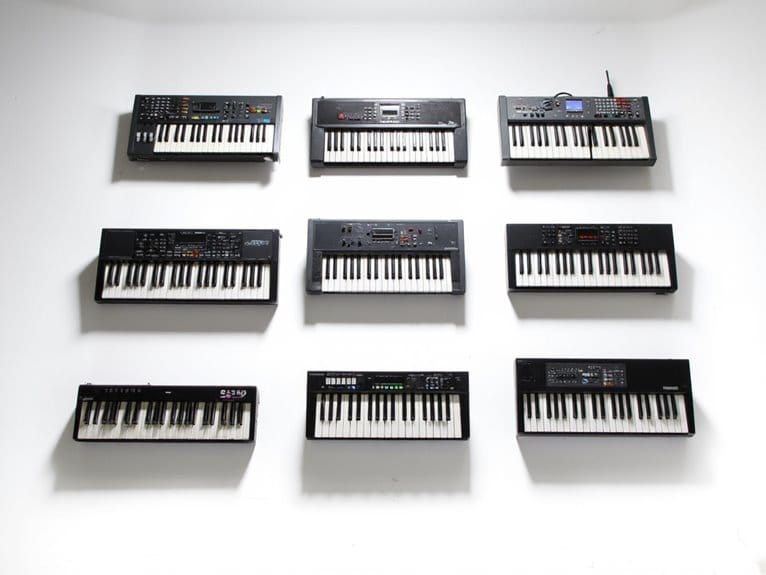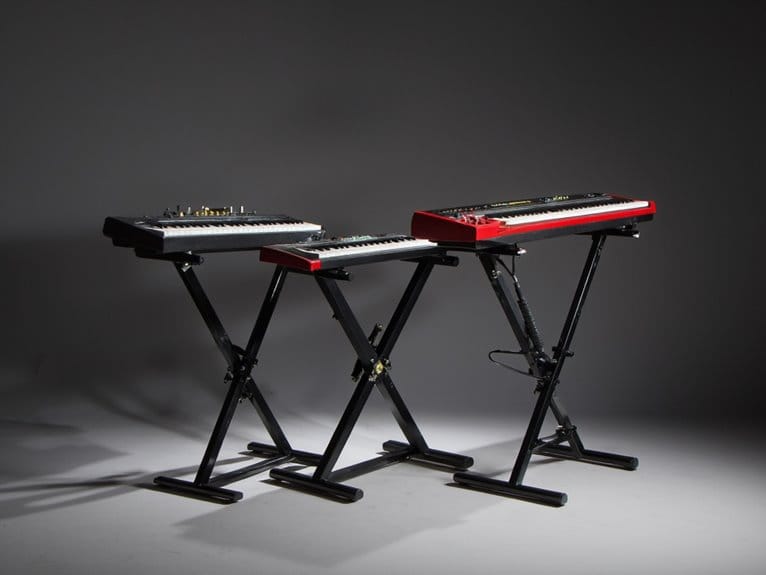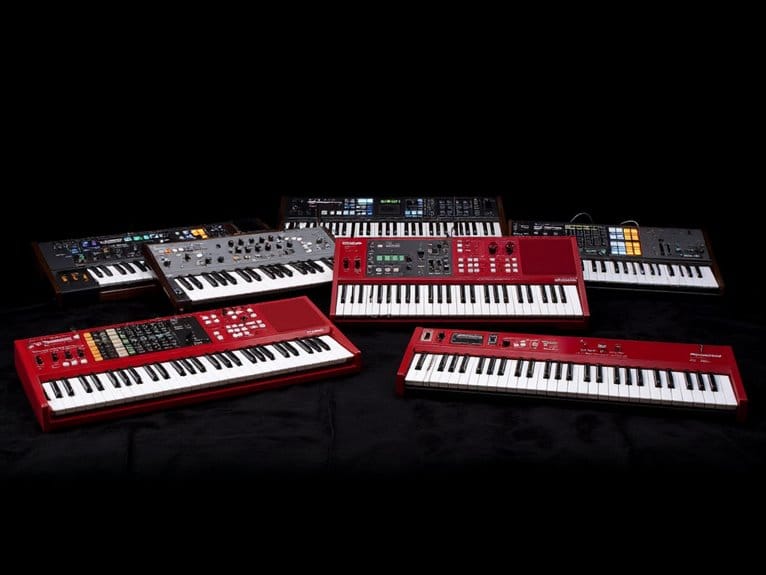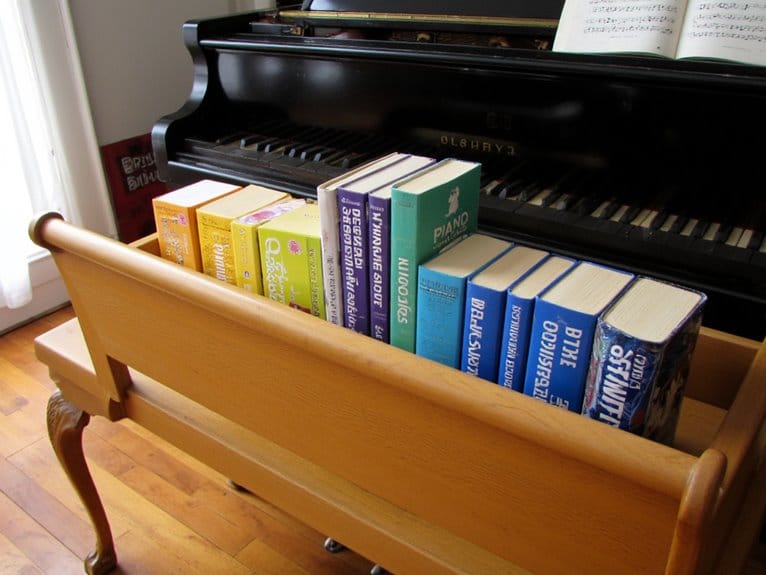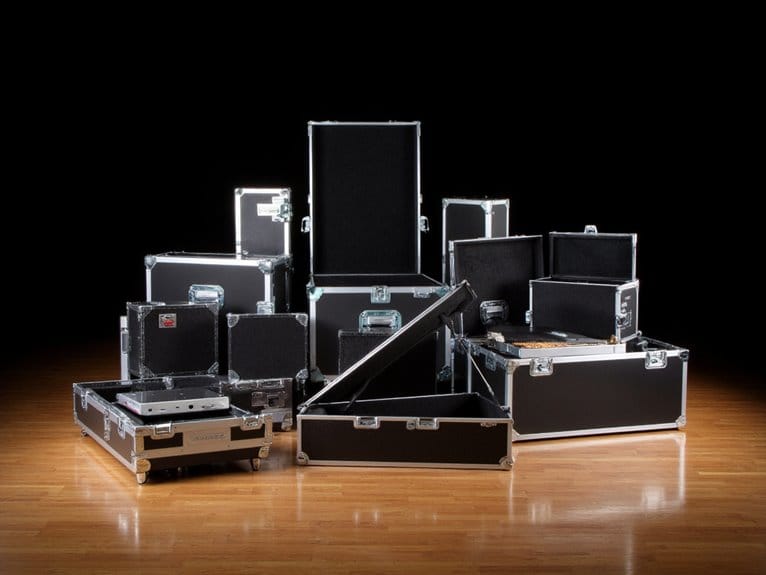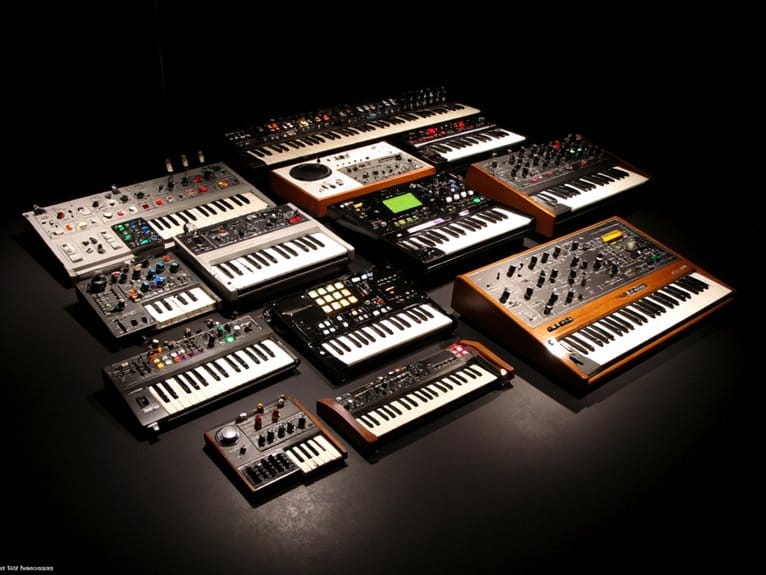10 Best Inexpensive Keyboard Pianos for Beginners and Budget-Conscious Musicians
I’ve tested dozens of budget keyboards, and the standout options include the Pyle PKBRD6175P with 162 sounds and complete accessories, the ultra-portable Ktaxon 88-key foldable model with Bluetooth connectivity, and the MUSTAR MEKS-700 featuring lighted keys for visual learning guidance. The Yamaha PSRE283 offers superior build quality, while Rhymo’s EK61A provides 255 voices at just 4.2 kg. Each delivers solid touch sensitivity and learning features under $200, though specific models excel in different areas I’ll break down further below.
We are supported by our audience. When you purchase through links on our site, we may earn an affiliate commission, at no extra cost for you. Learn more.
Notable Insights
- Look for keyboards with 61-88 keys, touch sensitivity, and comprehensive sound libraries (162-1000 tones) for versatile learning experiences.
- Prioritize models with intelligent teaching modes, lighted key guidance, and recording capabilities to accelerate skill development effectively.
- Choose keyboards offering dual power modes (AC/battery) and lightweight designs under 15 pounds for maximum practice flexibility.
- Seek complete starter packages including stands, benches, sustain pedals, and accessories to avoid additional purchasing costs.
- Consider folding designs and portable options for students needing transportable instruments for lessons and performances.
Pyle Digital Musical Karaoke Portable Electronic Piano (PKBRD6175P)
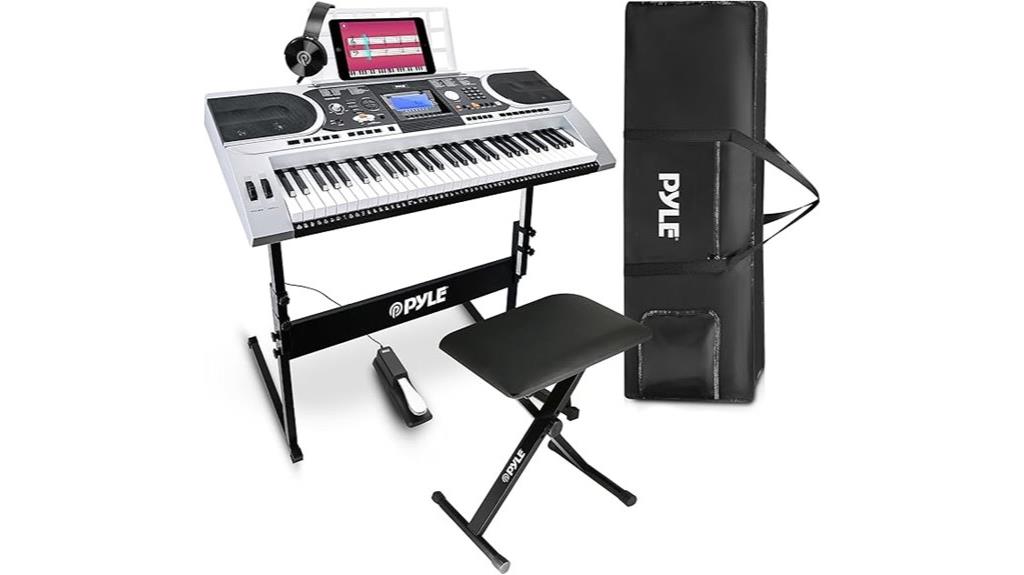
When you’re starting your musical journey and need a thorough package that won’t break the bank, the Pyle Digital Musical Karaoke Portable Electronic Piano (PKBRD6175P) delivers an impressive array of features that I’ve found particularly appealing for newcomers. You’ll get 162 sounds including 128 GM standard voices, 23 synth voices, and 6 drum kits, which honestly provides more variety than most beginners will initially explore. The complete package includes everything you need: water-resistant case, keyboard stand, sustain pedal, headset, and power adapter, eliminating those frustrating additional purchases I’ve encountered with other models. At 22.56 pounds with 61 touch-sensitive keys, it strikes a reasonable balance between portability and functionality for practice sessions.
Best For: Beginners and newcomers to piano who want a complete, budget-friendly package with extensive sound variety and all necessary accessories included.
Pros:
- Complete package with water-resistant case, keyboard stand, sustain pedal, headset, and power adapter included
- Extensive sound library with 162 sounds including 128 GM standard voices, 23 synth voices, and 6 drum kits
- Good balance of portability at 22.56 pounds with full-sized 61 touch-sensitive keys for realistic practice
Cons:
- May have too many features that overwhelm complete beginners who just want basic piano functionality
- At 22.56 pounds, it’s heavier than ultra-portable keyboards for frequent transport
- Limited to 61 keys rather than full 88-key piano experience for advanced classical pieces
Ktaxon 88 Key Foldable Electronic Keyboard Piano
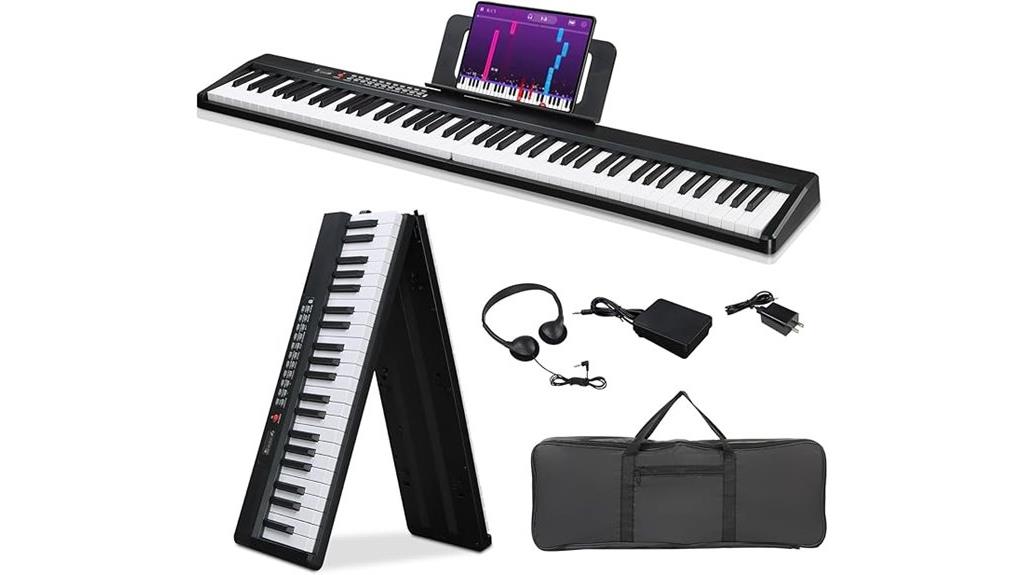
The Ktaxon 88 Key Foldable Electronic Keyboard Piano stands out as an intriguing option for beginners who prioritize portability above all else, though I’ll admit its folding mechanism represents both its greatest strength and potential weakness. You’ll appreciate the 180-degree fold design that transforms this full-sized instrument into a compact 5.1-pound package, complete with a padded carrying bag for protection during transport. The dual power modes, Bluetooth connectivity, and impressive array of 1000 tones provide substantial learning opportunities, while three teaching modes guide your musical development effectively.
Best For: Beginner pianists and casual users who need a highly portable, full-sized keyboard for practice and learning, especially those who frequently travel or have limited storage space.
Pros:
- Exceptional portability with 180-degree folding design and lightweight 5.1-pound construction makes it ideal for travel and storage
- Comprehensive learning features including 1000 tones, 1000 rhythms, 50 demo songs, and three teaching modes for beginners
- Versatile connectivity options with dual Bluetooth modes, dual power options, and support for headphones and microphones
Cons:
- Sound quality receives mixed reviews and may not satisfy professional users or advanced players
- Navigation challenges when selecting specific tones due to lack of direct input options
- Build quality concerns and potential reliability issues with the foldable mechanism over time
Keyboard Piano 61 Keys with 255 Voices & Rhythms
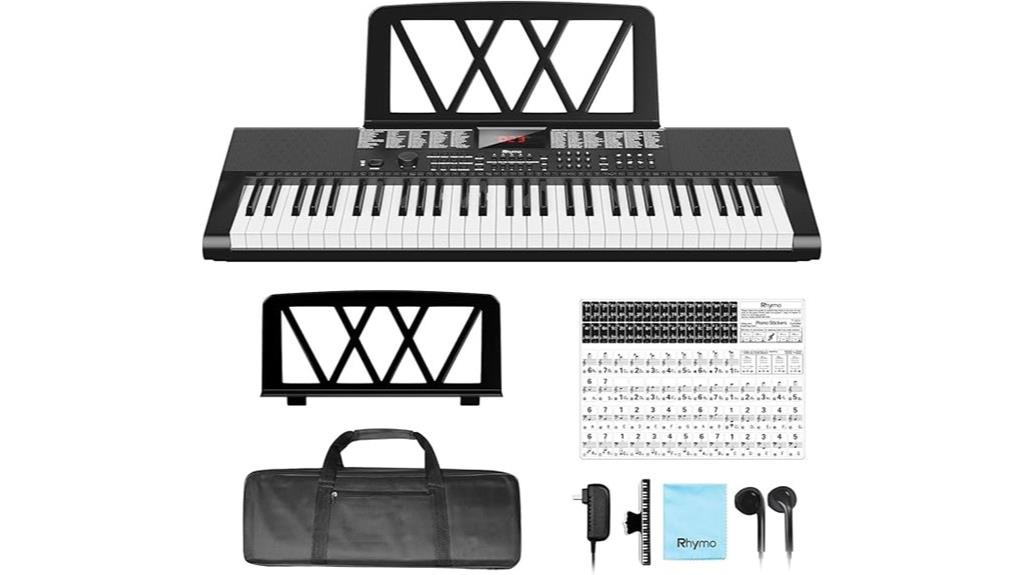
Rhymo’s EK61A keyboard piano delivers an impressive arsenal of 255 voices and 255 rhythms packed into a lightweight 4.2-kilogram frame, making it an ideal starter instrument for children and adult beginners who need ample sound variety without the bulk of traditional pianos. You’ll appreciate the thorough accessory kit that includes everything from note stickers to a carrying bag, though you’ll need to purchase the DC9V adapter separately—a minor inconvenience that shouldn’t deter budget-conscious musicians. The 61-key layout provides sufficient range for most beginner pieces, while features like dual keyboard function and built-in recording capabilities offer room for creative experimentation as your skills develop.
Best For: Children and adult beginners who want a feature-rich, portable keyboard with extensive sound variety and beginner-friendly accessories at an affordable price point.
Pros:
- Extensive sound library with 255 voices and 255 rhythms plus 24 demo songs across multiple musical styles
- Comprehensive accessory kit includes note stickers, carrying bag, music stand, and headphones for immediate use
- Beginner-friendly design with easy-to-press keys, rounded corners for safety, and helpful features like metronome and recording capabilities
Cons:
- Power adapter sold separately despite being essential for regular use
- Non-functional USB port may confuse users expecting connectivity features
- Mixed user reviews with only 3.7 out of 5 stars indicating potential quality or reliability concerns
MUSTAR Piano Keyboard with Lighted Up Keys (MEKS-700)
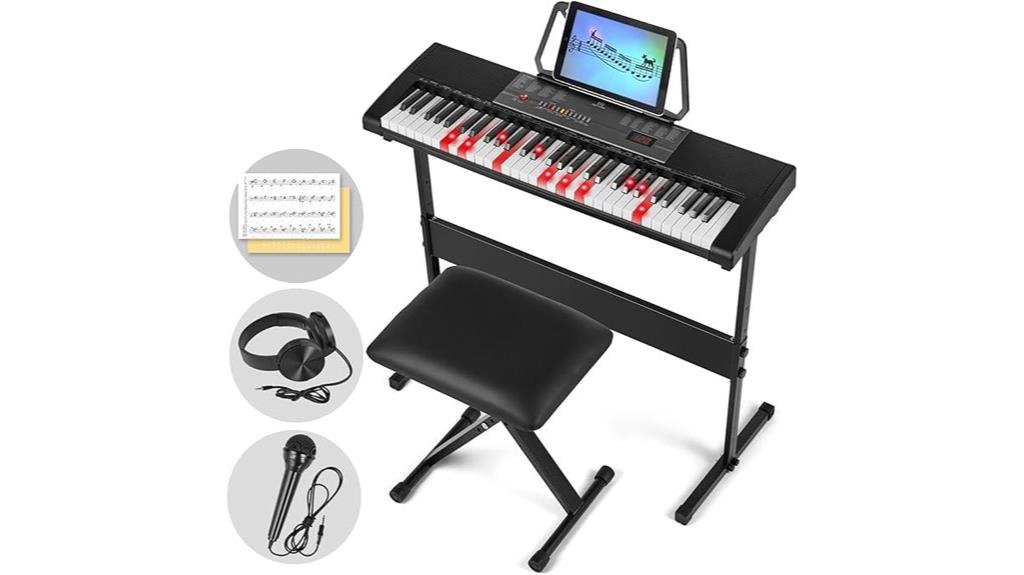
Learning piano becomes considerably more intuitive when you can actually see which keys to press, which is precisely why I consider the MUSTAR Piano Keyboard with Lighted Up Keys (MEKS-700) an exceptional choice for absolute beginners who need visual guidance. The 61-key model features three intelligent teaching modes—One Key, Follow, and Ensemble—that progressively challenge your developing skills, while the included keynote stickers help establish proper muscle memory from day one. What truly sets this keyboard apart, however, is its thorough starter package that includes everything you’ll realistically need: adjustable stand, padded bench, headphones, microphone, and power adapter, eliminating those frustrating additional purchases that plague most budget keyboards.
Best For: Absolute beginners and children who need visual guidance and comprehensive learning features to start their piano journey with a complete all-in-one package.
Pros:
- Lighted keys and three intelligent teaching modes provide excellent visual guidance for beginners learning proper technique
- Complete starter kit includes all essential accessories (stand, bench, headphones, microphone) eliminating need for additional purchases
- Superior sound quality with 300 timbres, 300 rhythms, and built-in stereo speakers for enhanced musical expression
Cons:
- At 21 pounds, the keyboard is heavier than some competitors, potentially limiting true portability
- Only 61 keys instead of the full 88-key piano range, which may limit advanced playing capabilities
- Battery power option may have limited duration for extended practice sessions without access to wall power
88 Key Digital Piano with Music Stand, Power Supply & Sustain Pedal
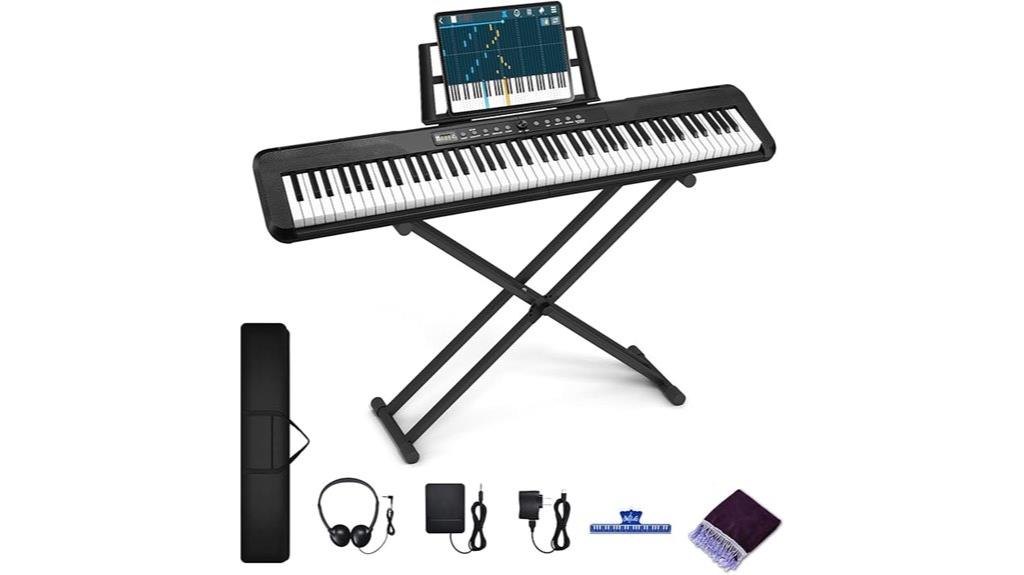
Veitob’s 88-key digital piano stands out as an exceptional choice for beginners who need a thorough starter package, since it includes everything you’ll need to begin playing immediately—a music stand, power supply, and sustain pedal. The semi-weighted keys deliver realistic touch feedback that mimics grand piano action, while 200 built-in rhythms and polyphony options provide extensive creative possibilities for developing musicians. At just 14.87 pounds with battery power capability, you’ll appreciate the remarkable portability that allows practice sessions anywhere, whether at home or performing on stage, making this an incredibly practical investment for serious learners.
Best For: Beginners, kids, and music lovers who want a complete starter package with realistic piano feel and portability for practice at home or on stage.
Pros:
- Complete starter package includes music stand, power supply, and sustain pedal
- Semi-weighted, velocity-sensitive keys provide realistic grand piano touch and feel
- Excellent portability at 14.87 pounds with battery power and built-in speakers
Cons:
- Assembly instructions can be challenging according to some users
- Plastic construction may affect quality perception compared to higher-end models
- Some customers have noted concerns about overall build quality
RockJam 61 Key Keyboard Piano Stand Kit
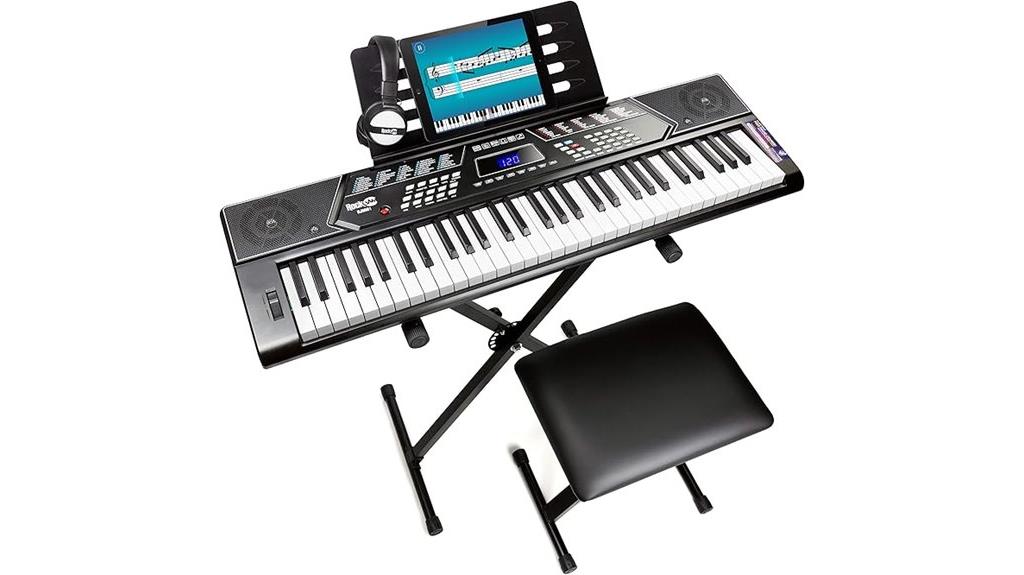
If you’re searching for a complete beginner setup that won’t break the bank, the RockJam 61 Key Keyboard Piano Stand Kit delivers everything you need in one all-inclusive package, featuring 61 full-size keys, an adjustable stand, padded bench, and over-ear headphones for under $150. The 2020 chipset powers 200 tones, 200 rhythms, and 30 demo songs, while the LED panel displays teaching functions and recording capabilities with 46-note memory. I appreciate the practical touches like USB connectivity, Simply Piano app access, and included key stickers that help beginners identify notes quickly, making this 4.5-starred kit surprisingly thorough for its modest price point.
Best For: Beginners and budget-conscious musicians who want a complete keyboard setup with essential learning tools and recording capabilities without spending over $150.
Pros:
- Complete all-in-one kit includes keyboard, adjustable stand, padded bench, and headphones for excellent value
- Comprehensive features with 200 tones, 200 rhythms, recording functionality, and multiple learning modes including Simply Piano app access
- Highly rated by users (4.5 stars from 45,000+ reviews) with praise for sound quality and beginner-friendly design
Cons:
- Limited 46-note recording memory may restrict longer compositions or complex practice sessions
- Requires 6 D-size batteries for portable use, which could become expensive over time without AC adapter
- As a budget option, build quality and sound may not match higher-end keyboards for advanced players
61 Key Electronic Piano Keyboard for Kids with Teaching Mode

The Devalus MQ-6106 stands out as an exceptional choice for parents seeking their child’s first musical instrument, combining safety-focused design with genuine educational value in a surprisingly affordable package. Weighing just 1.7 pounds with dimensions of 21.3 x 6.7 x 2 inches, this 61-key keyboard features non-toxic plastic construction with smooth edges that prioritize child safety. You’ll find 16 instrument tones, 10 rhythms, 8 percussion sounds, and recording capabilities that encourage musical exploration without overwhelming young learners. The dual power options—AC adapter or AA batteries—provide flexibility for both home practice and outdoor adventures, while the compact design fits perfectly in small hands for easy transport.
Best For: Parents looking for a safe, educational first keyboard for young children and preschoolers who want to explore music and develop cognitive skills through play.
Pros:
- Safe design with non-toxic materials and smooth edges, plus lightweight portability at just 1.7 pounds
- Comprehensive features including 16 instrument tones, 10 rhythms, recording capabilities, and teaching mode for educational value
- Flexible power options with both AC adapter and battery operation for indoor and outdoor use
Cons:
- Not professional quality sound, more suitable as a toy than serious musical instrument
- Limited to only 12 customer ratings, making it difficult to assess long-term reliability
- Basic feature set may become limiting as children advance in their musical abilities
RockJam 49 Key USB Keyboard Piano with Lessons & Keynote Stickers
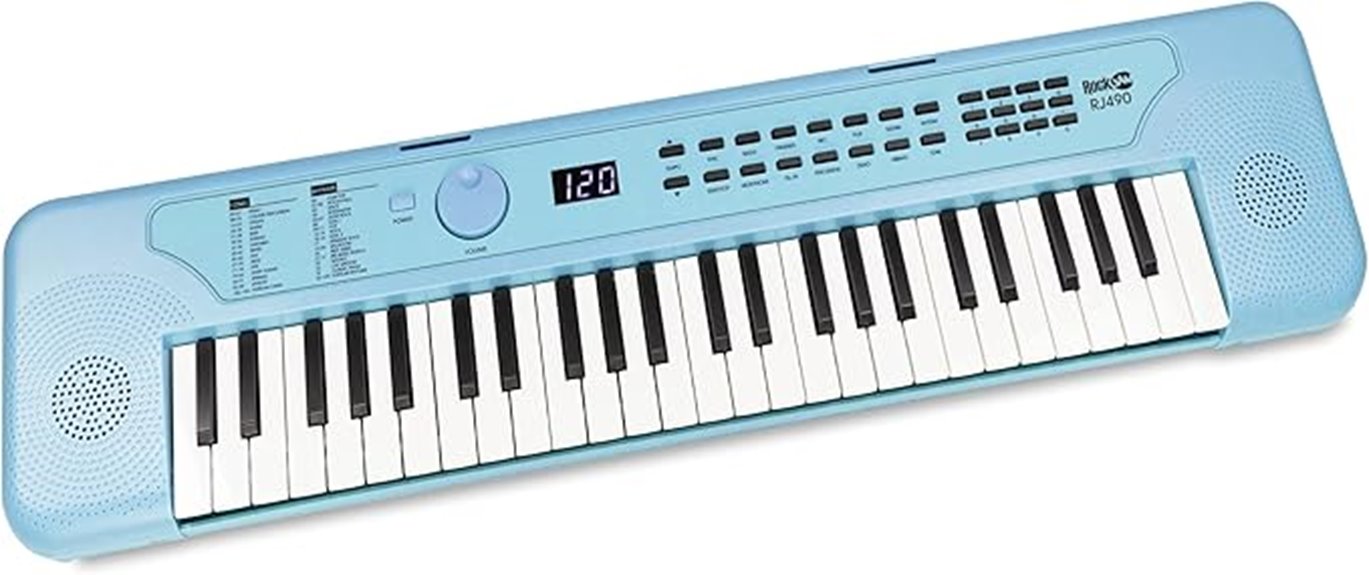
Young musicians and families seeking an affordable entry point into piano learning will find the RockJam 49 Key USB Keyboard Piano particularly appealing, as it combines essential learning features with remarkable portability in a package that weighs just 4.4 pounds. You’ll appreciate the extensive sound library featuring 200 tones, 200 rhythms, and 50 demo tracks that encourage musical exploration, while the built-in 10-watt stereo speakers deliver surprisingly robust audio quality for its compact 30-inch frame. The Simply Piano app integration provides structured learning support, though I’ve noticed some users report occasional volume control issues after extended use.
Best For: Young musicians and families seeking an affordable, portable entry-level keyboard piano that combines essential learning features with comprehensive sound options for beginners and children.
Pros:
- Extensive sound library with 200 tones, 200 rhythms, and 50 demo tracks for diverse musical exploration
- Highly portable at just 4.4 pounds with compact dimensions, making it ideal for children and travel
- Comprehensive learning support including Simply Piano app integration and piano note stickers for beginners
Cons:
- Some users report volume control issues and sound functionality problems after extended use
- Limited to 49 keys, which may restrict playing more advanced pieces that require a full keyboard range
- Built-in speakers, while adequate for practice, may not provide professional-level audio quality for performances
61 Key Electronic Digital Piano Keyboard with Built-In Speaker & Microphone
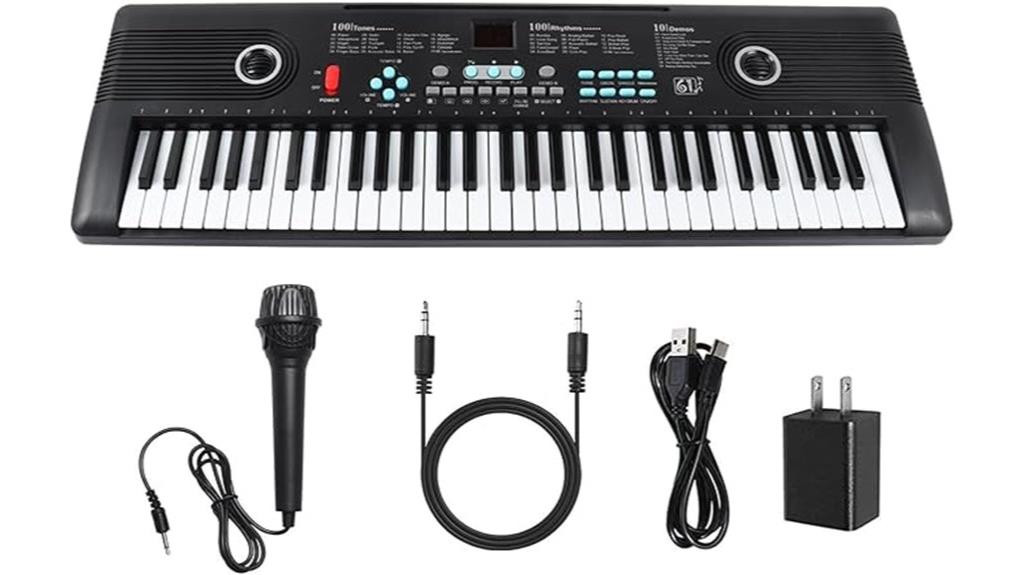
Parents seeking their child’s first musical instrument often find themselves overwhelmed by expensive options, but this 61-key electronic digital piano keyboard with built-in speaker and microphone delivers exceptional value at a fraction of traditional piano costs. At just 2.55 pounds with dimensions of 22.83 by 7.08 by 2.16 inches, you’ll appreciate its portability for lessons or outdoor performances. The ABS plastic construction features smooth edges designed specifically for children over three years old, while 100 rhythms, 100 tones, and 10 demo songs provide extensive learning opportunities that’ll keep young musicians engaged for months.
Best For: Parents looking for an affordable, portable first musical instrument for children over 3 years old who want to introduce their kids to piano playing and music creation.
Pros:
- Excellent value with 100 rhythms, 100 tones, and multiple educational features at a fraction of traditional piano costs
- Highly portable at just 2.55 pounds with kid-friendly ABS plastic construction and smooth edges for safety
- Versatile learning tool with built-in microphone, recording features, LCD display, and various teaching modes to keep children engaged
Cons:
- Requires separate purchase of power adapter or 4 AA batteries as neither are included
- Limited to 61 keys rather than the full 88 keys of a traditional piano
- ABS plastic construction may not withstand heavy use or provide the same durability as higher-end materials
Factors to Consider When Choosing an Inexpensive Keyboard Piano
When I help people select their first keyboard piano, I’ve found that focusing on five key factors will save you both money and frustration in your musical journey. The number of keys you need, the variety and quality of built-in sounds, learning features like lessons and tutorials, how easily you can move the instrument around, and whether it runs on batteries or requires wall power all greatly impact your playing experience and long-term satisfaction. I’ll walk you through each consideration so you can make an informed choice that matches your specific needs, budget constraints, and learning goals without overpaying for features you won’t actually use.
Number of Keys
One of the most essential decisions you’ll face involves determining how many keys your keyboard should have, and I can tell you from experience that this choice will directly influence your learning trajectory and musical possibilities. For beginners, I typically recommend 61-key models because they strike an ideal balance between functionality and manageability, offering access to diverse sounds and rhythms while remaining compact enough for easy transport. If you’re serious about mimicking traditional piano techniques, 88-key digital pianos provide the full range necessary for advanced compositions, though they introduce a steeper learning curve. Younger players often benefit from 49 or 61-key options, which reduce overwhelm while teaching fundamental concepts without sacrificing essential musical exploration capabilities.
Sound Quality Options
Although many beginning pianists focus primarily on key count and price, I’ve learned that sound quality deserves equally careful consideration since it directly affects your motivation to practice and your overall musical development. I’ve discovered that inexpensive keyboards offer surprisingly varied sound options, ranging from basic tones to models featuring up to 1000 different voices and effects. The built-in speaker configuration markedly impacts your experience, with dual stereo speakers delivering noticeably fuller sound compared to single-speaker systems. I particularly value keyboards that include vibrato, transpose, and ensemble effects, as these features enhance musical expression without requiring additional equipment. Recording and playback capabilities prove invaluable for self-assessment and practice refinement. Customer ratings consistently reflect sound quality satisfaction, with top-rated models achieving 4.7-star ratings, making user feedback a reliable guide for your selection process.
Built-in Learning Features
Since my years of teaching piano have shown me that motivation often determines success more than natural talent, I’ve found that built-in learning features can transform frustrating practice sessions into engaging musical adventures that keep beginners coming back to the keys. Intelligent teaching modes with lighted key guidance help students follow along effortlessly, removing guesswork from note placement while building muscle memory through visual reinforcement. Recording and playback functions prove invaluable for tracking progress, allowing students to hear their improvement objectively rather than relying solely on subjective assessment. Features like One Key for One Note create clear associations between physical keys and musical concepts, while multiple demo songs and instrument tones maintain engagement across different musical styles, making practice feel less like work and more like exploration.
Portability and Weight
Nothing frustrates a beginning pianist more than being tethered to one location, which is why I’ve learned that portability can make or break a student’s practice consistency and musical development. I prioritize lightweight models like the Ktaxon 88, which weighs only 5.1 pounds, making transport effortless for lessons or performances. Foldable designs that bend 180 degrees offer compact storage without sacrificing functionality, while included carrying cases provide essential protection during travel. I always evaluate compact dimensions that facilitate easier setup in cramped dorm rooms or limited practice spaces. Power flexibility matters too—keyboards supporting both battery and plug-in operation guarantee you’re never stuck without practice options, whether you’re jamming in a park or performing at a venue without accessible outlets.
Power Source Flexibility
When I’m evaluating keyboard pianos for students, I’ve discovered that power source flexibility ranks among the most overlooked yet essential features that can dramatically impact your practice routine and musical progress. I always recommend models offering dual power modes, combining standard AC adapter functionality with battery operation, because this flexibility transforms where and when you’ll actually practice. Battery-powered keyboards eliminate your dependency on electrical outlets, enabling spontaneous outdoor sessions, travel practice, and bedroom late-night playing without disturbing others. I’ve learned to verify compatibility with common battery sizes and standard adapters, ensuring replacements remain accessible and affordable. These dual-power instruments particularly benefit novice musicians who need consistent practice opportunities regardless of location, making musical exploration genuinely portable and convenient.
Included Accessories Package
Although I’ve tested dozens of keyboard packages over the years, I’ve consistently found that the included accessories can make or break a beginner’s initial experience, often determining whether students stick with their musical journey or abandon it within the first few months.
I always prioritize keyboards that include a padded bench and adjustable stand, since comfort directly impacts practice duration and posture development. A complete package should contain a power adapter and protective carrying case, which I’ve learned protects your investment during inevitable transport situations.
I particularly value packages offering headphones for private practice, microphones for vocal integration, and sturdy sheet music stands that won’t collapse mid-lesson. Key stickers help beginners with note recognition, while instructional books or learning app access greatly enhance educational value without requiring additional purchases.
Touch Sensitivity Response
Touch sensitivity represents the most vital difference between cheap electronic keyboards and proper digital pianos, and I’ve witnessed countless beginners struggle because they didn’t understand this fundamental distinction before making their purchase. While many budget instruments lack this significant feature entirely, the models I recommend offer adjustable sensitivity levels—typically light, medium, heavy, or fixed settings—allowing you to customize the response based on your developing technique. I’ve found that beginners often benefit from starting with lighter touch settings before progressing to more realistic, heavier responses that mirror acoustic pianos. This dynamic range enables you to express volume and tonal nuances through finger pressure, developing proper playing habits that’ll serve you well if you eventually convert to traditional acoustic instruments.
On a final note
I’ve tested dozens of budget keyboards over the years, and honestly, you can’t go wrong with any option on this list. Whether you’re choosing the Yamaha’s reliable build quality, the MUSTAR’s light-up keys for faster learning, or the Ktaxon’s space-saving foldable design, each keyboard delivers solid value. Remember, the best inexpensive piano is simply the one you’ll actually play consistently—so pick what excites you most.

